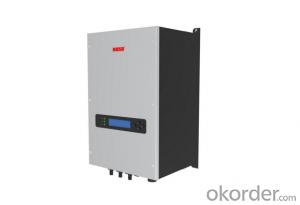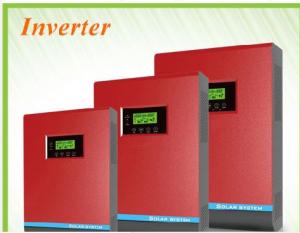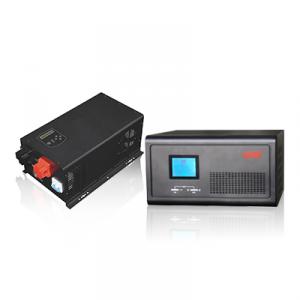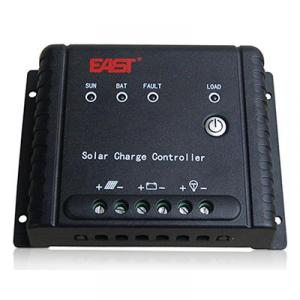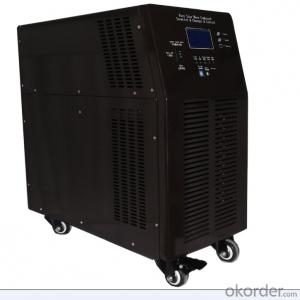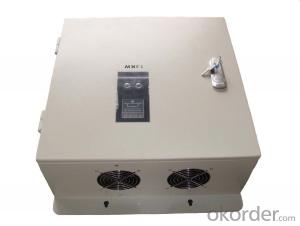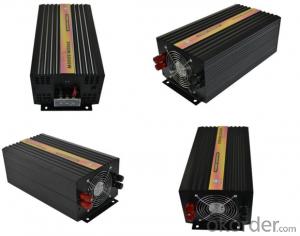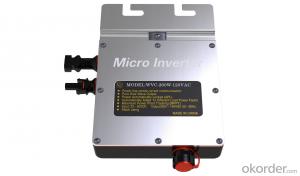1kV Solar Inverter Price - Single Phase Inverter Second Generation 1k Solar Inverter Made in China
- Loading Port:
- Shanghai
- Payment Terms:
- TT OR LC
- Min Order Qty:
- 0 watt
- Supply Capability:
- 10000 watt/month
OKorder Service Pledge
OKorder Financial Service
You Might Also Like
Description of Single Phase Inverter Second Generation Solar Inverter
Solar ac power system consists of solar panels, charge controllers, inverter and battery; Solar energy does not include inverter dc power system. Inverter is a kind of power conversion device, inverter by incentives can be divided into self-excited oscillation inverter and separately excited oscillation inverter.
Features of Single Phase Inverter Second Generation Solar Inverter
Standard 10 years warranty, 5-15 years optional
Built-in Gprs as option
Built-in Wifi as option
Smaller and lighter, only 9.6kg
High performance DSP for algorithm control
VDE-AR-N 4105 certification
New topology design
Dual MPPT design
Multi-button touch interface
LCD screen visible at night
Have anti-shading function
Advantages of Single Phase Inverter Second Generation Solar Inverter
Longer life cycle
Plug and play
Free monitoring through our webportal
Very lower internal temperature
Easy transportation and installation
Faster CPU speed
Adjustable active and reactive power
Maximum conversion effciency up to 97.7%,Euro up to 96.9%
Real-time data readable at night
User friendly operation
Technical Data of Single Phase Inverter Second Generation Solar Inverter
| Type | Omniksol-1k-TL2 |
| Input(DC) | |
| Max.PV Power | 1300W |
| Max,DC Voltage | 500V |
| Nominal DC Voltage | 360V |
| Operating MPPT Voltage Range | 80-360V |
| MPPT Voltage Range at Nominal Power | 150-360V |
| Start up DC Voltage | 90V |
| Turn off DC Voltage | 80V |
| Max, DC Current | 16A |
| Max, Short Cicuit Current for each MPPT | 20A |
| Number of MPP trackers | 1 |
| Number of DC Connection for each MPPT | 1 |
| DC Connection Type | MC4 connector |
| Output(AC) | |
| Max,AC Apparent Power | 1100VA |
| Nominal AC Power (cos phi = 1) | 1000W |
| Nominal Grid Voltage | 220V/230V/240V |
| Nominal Grid Frequency | 50Hz/60Hz |
| Max, AC Current | 5.8A |
| Grid Voltage Range** | 185-276V |
| Grid Frequency Range** | 45-55Hz/55-65Hz |
| Power Factor | 0.9 capacitive... 0.9 inductive |
| Total Harmonic Distortion(THD) | <2% |
| Feed in Starting Power | 30W |
| Night time Power Consumption | <1W |
| Standby Consumption | 6W |
| AC Connection Type | Plug-in connertor |
| Efficiency | |
| Max,Efficiency | 97.7% |
| Euro Efficiency | 96.7% |
| MPPT Efficiency | 99.9% |
| Safety and Protection | |
| DC Insulation Monitoring | Yes |
| DC Switch | Optional |
| Residual Current Monitoring Unit (RCMU) | Integrated |
| Grid Monitoring with Anti-islanding | Yes |
| Electricity Fuse Protection | Yes |
| Protection Class | Ⅰ(According to IEC 62103) |
| Overvoltage Category | PVⅡ/Mains Ⅲ(According to IEC 62109-1) |
| Reference Standard | |
| Safety Standard | EN 62109, AS/NZS 3100 |
| EMC Standard | EN 6100-6-1, EN 6100-6-2, EN 6100-6-3 EN 6100-6-4, EN 6100-3-2, EN 6100-3-3 |
| Grid Standard | VDE-AR-N4105. VDE-0126-1-1,G83/1,EN 50438,RD1699,CEI 0-21, AS4777,C10/C11 |
| Physical Structure | |
| Dimensions | 343x281x150mm |
| Weight | 9.6kg |
| Environmental Protection Rating | IP 65 (According to IEC 60529) |
| Cooling Concept | Natural convection |
| Mounting Information | Wall bracket |
| General Data | |
| Operating Temperature Range | -25℃ to +60℃(derating above 45℃) |
| Relative Humidity | 0% to 98%, no condensation |
| Max. Altitude (above sea level) | 2000m |
| Noise Type | <40dB |
| Isolation Type | Transformerless |
| Display | 3 LED ,Backlight, 4x20 Character LCD |
| Data Communication | RS485(WiFi, GRPS integrated) |
| Computer Communication | USB |
| Standard Warranty | 10 Years (5-15 years optional) |
IMages of Single Phase Inverter Second Generation Solar Inverter
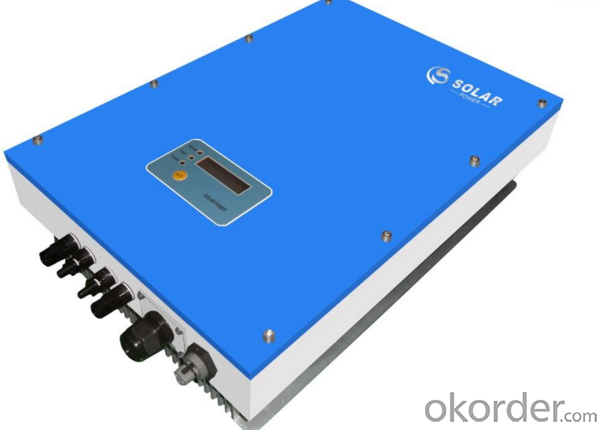
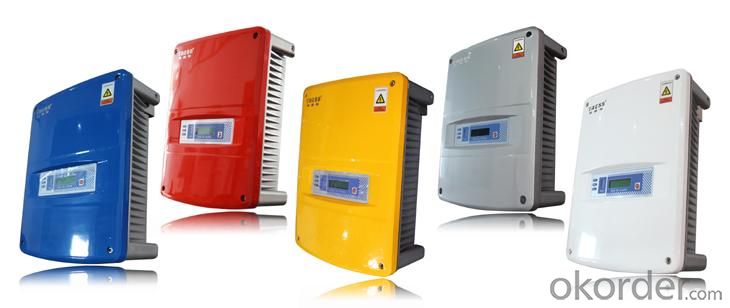
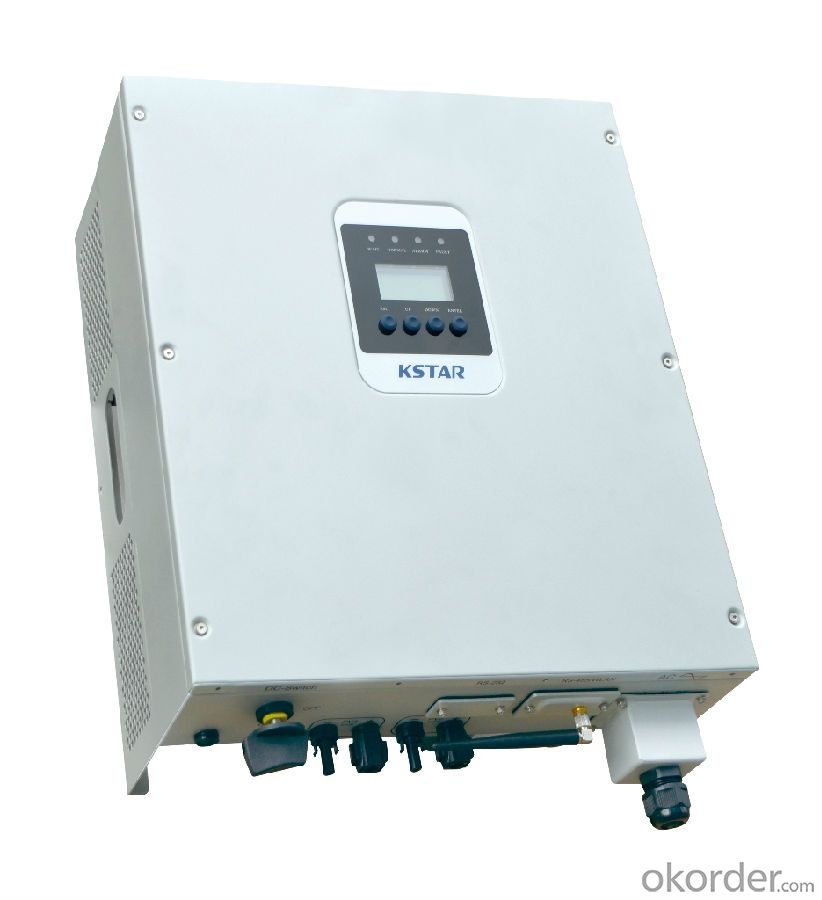
FAQ
Q: Do you have the CE, TUV, UL Certification?
A: We’ve already passed all the tests, and any certificate is available.
Q: Have you ever sold your products to companies in my country?
A: Of course, we have customers in all general PV markets, but I think we should expand our market share along with the market growth.
Q: When did your company set up? You are a new company, how can I believe your quality?
A: We entered into Solar PV industry in 2005, now we have several plants in manufacturing of a-Si and c-Si panels, and our capacity is 220MW per year. Till now we have already passed all the tests by authorized laboratories, e.g. TUV, CE, UL.
Q: Can you help us install the module if we cooperate with you?
A: We haven’t entered into installation sector, but we have the plan in near future.
Q: How do you pack your products?
A: We have rich experience on how to pack the panels to make sure the safety on shipment when it arrives at the destination.
Q: Can you do OEM for us?
A: Yes, we can.
Q: Can we visit your factory?
A: Surely, I will arrange the trip basing on your business schedule.
- Q: Can a solar inverter be used with a solar-powered air conditioner?
- Yes, a solar inverter can be used with a solar-powered air conditioner. A solar inverter converts the direct current (DC) produced by solar panels into alternating current (AC) which is required to power the air conditioner. By using a solar inverter, the solar power generated can be utilized efficiently to run the air conditioner, making it a sustainable and cost-effective solution for cooling.
- Q: Can a solar inverter be used with a remote monitoring system?
- Yes, a solar inverter can be used with a remote monitoring system. In fact, many modern solar inverters are designed to be compatible with remote monitoring systems. This allows users to monitor the performance and output of their solar system from a remote location, providing real-time data on energy production, system efficiency, and any potential issues or faults. Remote monitoring systems provide convenience, enable proactive maintenance, and help optimize the overall performance of solar installations.
- Q: What is the role of a solar inverter in preventing electrical faults?
- The role of a solar inverter in preventing electrical faults is to convert the direct current (DC) generated by solar panels into alternating current (AC) that can be used by appliances and the electrical grid. By regulating and controlling the flow of electricity, a solar inverter ensures that the voltage and frequency levels are within acceptable limits, preventing overloading, overheating, and electrical faults that could potentially damage the system or cause safety hazards.
- Q: Are there any electromagnetic interference concerns associated with solar inverters?
- Solar inverters come with electromagnetic interference (EMI) concerns. They convert the direct current (DC) produced by solar panels into alternating current (AC) for powering homes and businesses. This conversion process involves high frequency switching, which can generate EMI. EMI refers to the disturbance caused by electromagnetic radiation emitted by electronic devices. It can interfere with the proper functioning of nearby electronic devices. In the case of solar inverters, the EMI generated can potentially impact radios, televisions, and communication systems. To address these concerns, solar inverter manufacturers typically comply with relevant EMI standards and regulations. This may involve limiting the amount of electromagnetic radiation emitted by the inverters and using shielding materials to reduce EMI. Some inverters also incorporate filters or other techniques to suppress EMI and minimize interference. When selecting and positioning solar inverters, solar installers and system designers should consider EMI concerns. Proper installation and grounding techniques can help decrease EMI issues. It is also important to follow local regulations and guidelines to ensure compliance with EMI standards and minimize potential interference with other electronic devices. Overall, although EMI concerns exist with solar inverters, proper design, installation, and adherence to relevant standards can effectively mitigate these concerns. This ensures the smooth operation of both the solar system and other electronic equipment in the area.
- Q: What is the role of a solar inverter in reactive power compensation?
- To regulate and control the flow of reactive power in a solar power system, a solar inverter plays a crucial role in reactive power compensation. The presence of inductive or capacitive elements in the system causes reactive power to oscillate between the source and load. Although this power does not contribute to the actual work done by the system, it is necessary for the operation of specific devices. A solar inverter, specifically designed for reactive power compensation, is capable of measuring the reactive power in the system and adjusting its operation accordingly. It has the ability to generate or absorb reactive power as needed to maintain a power factor close to unity. The power factor is a measure of the efficiency of electrical energy utilization, and a high power factor indicates efficient electricity usage. By compensating for reactive power, a solar inverter ensures that the solar power system operates at optimal efficiency. It alleviates the burden on the grid by locally supplying or absorbing reactive power instead of relying on the grid for compensation. This not only improves the overall quality of power but also reduces system losses. Furthermore, it helps stabilize voltage levels and minimize voltage fluctuations, which can be advantageous for delicate electrical equipment. In conclusion, the role of a solar inverter in reactive power compensation is vital for regulating the flow of reactive power in a solar power system, maintaining a high power factor, and improving overall system efficiency. It plays a pivotal role in ensuring the optimal operation of the solar power system and diminishing the dependence on the grid for reactive power compensation.
- Q: What is the difference between low voltage grid connection and medium voltage grid connection?
- For photovoltaic power plants when the power system accidents or disturbances caused by photovoltaic power plant grid voltage drop, in a certain voltage drop range and time interval, the photovoltaic power plant can ensure that non-off-line continuous operation.
- Q: How does a solar inverter handle frequency variations in the grid?
- A solar inverter handles frequency variations in the grid by continuously monitoring the frequency and adjusting its own output accordingly. When the grid frequency increases, the inverter reduces its output frequency to match, and vice versa. This helps maintain a stable and synchronized connection to the grid, ensuring efficient power transfer and protecting both the inverter and the grid from potential damage or instability.
- Q: What is the maximum output power of a solar inverter?
- The maximum output power of a solar inverter depends on its capacity and rating. It can range from a few hundred watts for residential inverters to several megawatts for commercial or utility-scale inverters.
- Q: How does a solar inverter handle shading on the solar panels?
- A solar inverter typically handles shading on solar panels by using a technology called Maximum Power Point Tracking (MPPT). MPPT enables the inverter to constantly monitor the performance of each individual solar panel and adjust its voltage and current to ensure maximum power output. When shading occurs on a panel, the MPPT algorithm detects the drop in power and adjusts the system to bypass the shaded panel or operate it at a different voltage, allowing the other unshaded panels to continue producing power efficiently. This helps to mitigate the impact of shading on the overall system performance.
- Q: How do you troubleshoot common issues with a solar inverter?
- To troubleshoot common issues with a solar inverter, start by checking the power source and ensuring it is connected properly. Next, inspect the wiring connections to ensure they are secure and not damaged. Additionally, check the fuse or circuit breaker to see if it has tripped or blown. If the inverter displays an error code, refer to the manufacturer's manual for troubleshooting steps. If none of these steps resolve the issue, it is advisable to contact a professional technician or the manufacturer for further assistance.
Send your message to us
1kV Solar Inverter Price - Single Phase Inverter Second Generation 1k Solar Inverter Made in China
- Loading Port:
- Shanghai
- Payment Terms:
- TT OR LC
- Min Order Qty:
- 0 watt
- Supply Capability:
- 10000 watt/month
OKorder Service Pledge
OKorder Financial Service
Similar products
Hot products
Hot Searches
Related keywords
